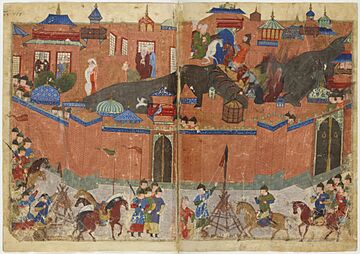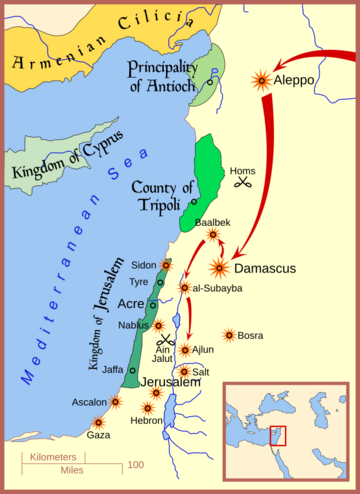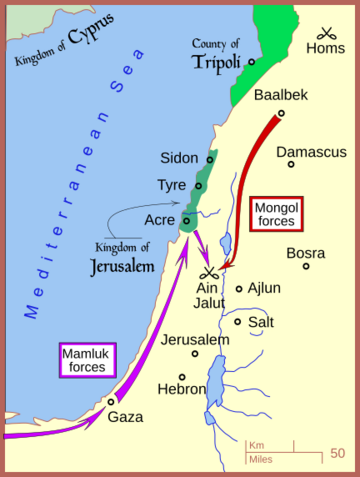Qutuz facts for kids
Quick facts for kids Sayf al-Din Qutuz |
|||||
|---|---|---|---|---|---|
| The Victorious King Sword of the Faith Qutuz |
|||||
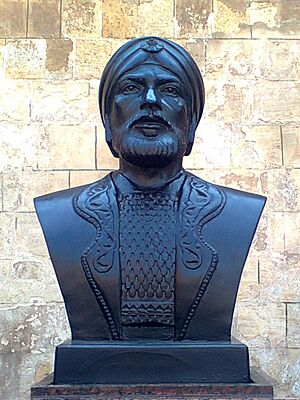
Qutuz bust in Cairo
|
|||||
| Sultan of Egypt | |||||
| Reign | November 1259 – 24 October 1260 | ||||
| Predecessor | Al-Mansur Ali | ||||
| Successor | Baibars | ||||
| Sultan of Syria | |||||
| Reign | September 1260 – 24 October 1260 | ||||
| Successor | Baibars | ||||
| Born | 2 November 1221 Khwarazmian Empire |
||||
| Died | 24 October 1260 (aged 38) Salihiyah, Egypt |
||||
| Burial | Cairo | ||||
| Spouse | Gulńar | ||||
|
|||||
| Religion | Islam | ||||
Sayf al-Din Qutuz (Arabic: سيف الدين قطز; died 24 October 1260) was a powerful Mamluk Sultan of Egypt. He ruled for less than a year, from 1259 until his death in 1260. However, he was a key leader for two decades before becoming Sultan.
Qutuz was sold into slavery in Egypt but rose to become a vice-sultan for over 20 years. He played a big part in defeating the Seventh Crusade, which attacked Egypt in 1249–1250. In 1259, the Mongols threatened Egypt. Qutuz took control of the army and removed the young Sultan Al-Mansur Ali, who was only 15. The Mongols had already conquered important Islamic cities like Baghdad and those in Syria. Egypt became their next target. Qutuz led the Egyptian Mamluk army north to fight the Mongols. The Mongols had even made a deal with the Crusaders, who were Egypt's old enemies.
The Battle of Ain Jalut happened on 3 September 1260. It was fought in southeastern Galilee between the Egyptian Mamluk army and the Mongols. Qutuz's forces completely defeated the Mongols. This battle is seen as a major turning point in history. Qutuz was killed by another Mamluk leader, Baibars, on his way back to Cairo after the victory. Even though Qutuz's rule was short, he is remembered as one of the most important Mamluk sultans in Islamic history. His name Qutuz means 'Vicious beast'. He got this name because he fought fiercely, even as a child.
Contents
Early Life and Rise to Power
Qutuz was a Turkic prince from Persia. The Mongols captured him around 1231 when they conquered his home, the Khwarazmian dynasty. He was taken to Damascus and sold to an Egyptian slave merchant. This merchant then sold him to Aybak, who was the Mamluk Sultan in Cairo. Some stories say Qutuz was related to Ala ad-Din Muhammad II, a ruler of the Khwarazmian Empire.
Qutuz became a very important Mamluk under Sultan Aybak. In 1253, he became Aybak's vice-sultan. When Aybak was killed in 1257, Qutuz remained vice-sultan for Aybak's son, al-Mansur Ali. Qutuz led the Mamluks who arrested Aybak's widow, Shajar al-Durr. They then made al-Mansur Ali the new Sultan of Egypt. In 1257 and 1258, Qutuz defeated attacks from Al-Karak, which were supported by other Mamluks.
In February 1258, the Mongol army destroyed Baghdad. They killed many people and the Abbasid Caliph Al-Musta'sim. The Mongols then moved towards Syria. The Syrian ruler, an-Nasir Yusuf, received a threatening letter from the Mongol leader Hulagu. Vice-Sultan Qutuz and the Egyptian leaders were worried when an-Nasir Yusuf asked Egypt for urgent help. The leaders met with the 15-year-old Sultan Al-Mansur Ali. Qutuz told them that Egypt needed a strong leader to fight the Mongols. So, on 12 November 1259, Qutuz removed Al-Mansur Ali from power. When Qutuz became the new Sultan, he promised the leaders they could choose another sultan after he defeated the Mongols.
Qutuz kept Emir Faris ad-Din Aktai al-Mostareb as the army's commander. He then started getting ready for battle.
The Mongol Threat to Egypt
Hulagu and his forces were moving towards Damascus. Some Syrian leaders suggested that an-Nasir Yusuf should surrender to Hulagu to save themselves and Syria. Baibars, who was at the meeting, was angry about this idea. The Mamluks decided to kill an-Nasir Yusuf that night. But he escaped to the citadel of Damascus with his brother. Baibars and the Mamluks then left Syria and went to Egypt. Sultan Qutuz welcomed them warmly and gave Baibars the town of Qalyub. When an-Nasir Yusuf heard the Mongols were near Aleppo, he sent his family and money to Egypt. People in Damascus and other Syrian towns started to flee.
After seven days, the Mongols attacked Aleppo. They destroyed the city and killed many people. When an-Nasir Yusuf heard about Aleppo, he fled towards Egypt. He left Damascus and its people without protection. However, Qutuz would not let him enter Egypt. An-Nasir Yusuf stayed at the border, while his leaders left him and entered Egypt. Sultan Qutuz ordered that an-Nasir Yusuf's jewels and money be taken and sent to Egypt with his family. Sixteen days after Aleppo fell, Damascus surrendered without a fight. The Mamluks captured an-Nasir Yusuf and sent him to Hulagu.
With the main Islamic cities in Syria and Baghdad conquered, Egypt became the new center of Islamic power. It was Hulagu's next target. Hulagu sent messengers to Cairo with a threatening letter. He told Qutuz to surrender to the Mongols. Qutuz's answer was to execute the messengers. Their bodies were cut in half, and their heads were placed on the Bab Zuweila gate in Cairo. Instead of waiting for the Mongols to attack, Qutuz decided to gather an army and fight them outside Egypt. People from Morocco in Egypt fled west, and people from Yemen went back to Yemen and Hejaz.
Qutuz went to Al-Salihiyya and gathered his commanders to decide when to march against the Mongols. But the leaders were scared. Qutuz shamed them into joining him. He said, "Leaders of the Muslims, you have been fed by the country's money, and you hate to be invaded. I will go alone. Whoever wants to join me should do so. Whoever does not want to join me should go home. But those who do not join will be guilty of not defending our women."
Qutuz ordered Baibars to lead a group to Gaza. Their job was to watch the small Mongol army there. Baibars easily defeated them. After a day in Gaza, Qutuz led his army along the coast towards Acre. Acre was a city still held by the Kingdom of Jerusalem Crusader state. The Crusaders were usually enemies of the Mamluks. The Mongols had even asked the Crusaders to join them. However, that year, the Crusaders saw the Mongols as a bigger threat. Qutuz suggested an alliance with the Crusaders against the Mongols, but the Crusaders chose to stay neutral. They did allow Qutuz and his army to travel through their land without trouble. They also let them camp and get supplies near Acre. Qutuz and his army stayed there for three days. Then they heard that the Mongols had crossed the Jordan River. Qutuz and Baibars then led their forces to meet the Mongols at Ain Jalut.
The Battle of Ain Jalut
The Battle of Ain Jalut was fought on 3 September 1260. It was one of the most important battles in history and a major turning point. Just ten years before, in 1250, the Bahariyya Mamluks (including Qutuz, Baibars, and Qalawun) had led Egypt against the Seventh Crusade of King Louis IX of France. The Mongol army at Ain Jalut was led by Kitbuqa, a Christian Mongol. He was joined by the Christian king of Cilician Armenia and the Christian prince of Antioch.
After the fall of Khawarezm, Baghdad, and Syria, Egypt was the last stronghold of Islam in the Middle East. The Crusader strongholds along the coast were also a serious danger to the Islamic world. So, the future of Islam and even the Christian West depended on the result of this battle.
Baibars, who was known as a fast commander, led the first attack. He successfully tricked the Mongol army into going to Ain Jalut, where the main Egyptian army led by Qutuz was waiting. At first, the Egyptians struggled against the Mongol attack. The left side of their army was badly damaged and scattered. But Qutuz stood firm. He threw his helmet into the air and shouted, "O Islam!" He then charged towards the damaged part of his army, followed by his unit. The Mongols were pushed back and fled to an area near Beisan. Qutuz's forces quickly followed them. But the Mongols managed to regroup and launched a successful counterattack. Qutuz cried loudly three times, "O Islam! O God, grant your servant Qutuz a victory against the Mongols!"
The Mongols and their Christian allies were then defeated by Qutuz's army. They fled to Syria, where local people attacked them. Qutuz kissed the ground and prayed while the soldiers collected the spoils of war. Kitbuqa, the Mongol army's commander, was killed, and his head was sent to Cairo.
This was the first defeat the Mongols had suffered since they began attacking the Islamic world. They fled from Damascus, then from all of northern Levant. Qutuz entered Damascus with his army. He sent Baibars to Homs to clear out any remaining Mongols. Qutuz appointed Alam ad-Din Sonjar as his deputy in Damascus. He also gave Aleppo to al-Malik al-Said Ala'a ad-Din as the Emir of Mosul. A new Abbasid Caliph was also about to be chosen by Qutuz. The region of Levant, from Egypt's border to the Euphrates River, was freed from Mongol control. After this victory, the Mamluks extended their rule to the Levant. The Ayyubids and others recognized them as the rightful rulers.
When Hulagu heard about the Mongol army's defeat, he executed an-Nasir Yusuf near Tabriz. Hulagu kept threatening the Mamluk Sultanate. But soon, he faced major conflicts with the Mongols of the Golden Horde in the western part of the Eurasian Steppe during the Berke–Hulagu war. Hulagu died in 1265 and never got revenge for the Mongol defeat at Ain Jalut.
Some of the earliest explosive hand cannons (called midfa in Arabic) were used by the Mamluk Egyptians during the battle. They used them to scare the Mongol horses and cavalry, causing confusion in their ranks. The Mamluks under Qutuz then went on to take back all of Iraq and Syria. The last city the Mamluks retook before Qutuz's death was the great city of Baghdad.
Assassination of Qutuz
On his way back to Cairo, Qutuz was killed during a hunting trip in Salihiyah. Both modern and older Muslim historians, like al-Maqrizi, say that Baibars was involved in the killing. Al-Maqrizi explains that the leaders who struck down Qutuz were Emir Badr ad-Din Baktut, Emir Ons, and Emir Bahadir al-Mu'izzi. Western historians directly blame Baibars for the plot. Muslim writers from the Mamluk era said Baibars wanted revenge for the killing of his friend, Faris ad-Din Aktai, during Sultan Aybak's rule. Another reason might have been Qutuz's decision to give Aleppo to al-Malik al-Said Ala'a ad-Din instead of to Baibars, as he had promised before the Battle of Ain Jalut.
Qutuz was first buried in Al-Qusair. Later, he was reburied in a cemetery in Cairo, Egypt. Baibars returned to Cairo, where people were celebrating the victory over the Mongols. He became the new Sultan. Baibars was immediately liked by the people because he removed the war taxes that Qutuz had put in place.
Coins of Qutuz
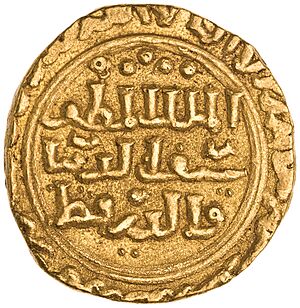
The coins made during Qutuz's rule are special in Mamluk history. Only his name and titles were written on them. These titles were: al-Malik al-Muzafar Saif al-Donya wa al-Din ("The victorious king, sword of the temporal world and of the faith") and al-Muzafar Saif al-Din ("The victorious sword of faith").
|
See also
- List of rulers of Egypt
- Mosque of Amr ibn al-As


